INDUSTRIAL &
TERMINAL RAILROADS &
RAIL-MARINE OPERATIONS
OF BROOKLYN, QUEENS, STATEN
ISLAND, BRONX &
MANHATTAN:
CNJ CRRNJ 3rd Third Avenue Lincoln Avenue Harlem River
|
BRONX
TERMINAL & RAILROAD CENTRAL RAILROAD OF NEW JERSEY |
 |
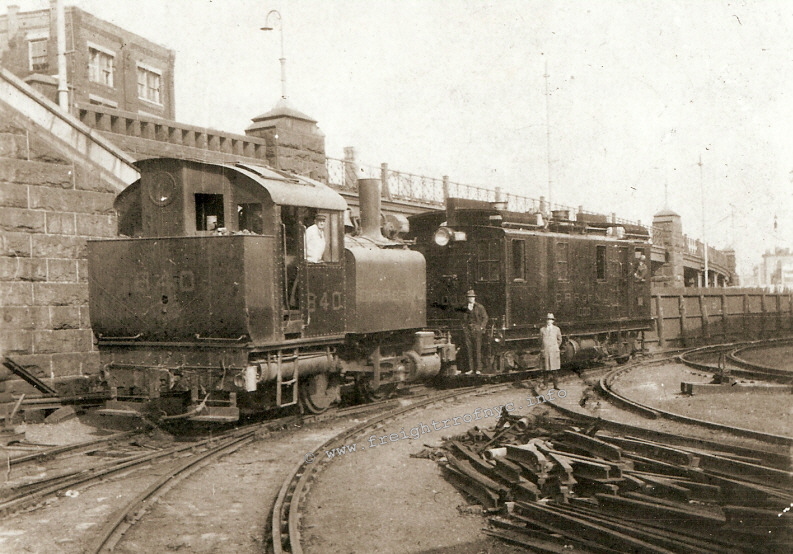
#840 & #1000 - November 1925 - Bronx Terminal,
Bronx, NY
"Changing of the Guard"
F. T. Reilly collection
courtesy of J. Franz
added 22 March 2010
.
|
updated: |
||
|
|
||
|
update summary: |
date: | chapter: |
| 1935, 1947, 1951 Sanborn Fire Insurance Maps added |
01 January 2023 | Property & Facilities |
.
.

.
.
| Property & Facilities | Trackage | ||
| Film Footage | Locomotive Photos |
Locomotive Roster builders data, previous owners |
|
| Modelling | Special Thanks |
.. ..
.
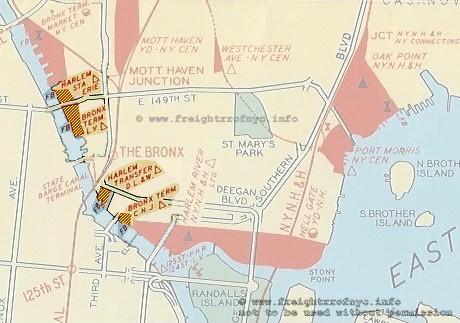
Port of New York Authority
New York Harbor Terminal, July 1943
.
.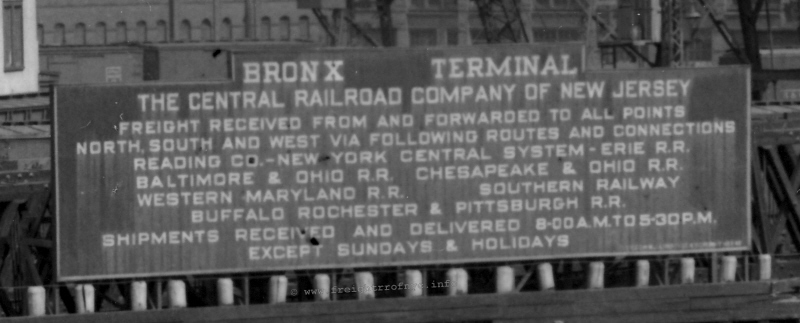
Billboard mounted on bulkhead in front of floatbridge - unknown
date
courtesy of T. Warris
added 16 February 2010
.
The Central Railroad of New Jersey (CRRNJ or CNJ) was not new to operations in the Bronx, and had originally utilized the shared Harlem Transfer facility along with the Baltimore & Ohio, Erie and the Delaware, Lackawanna & Western Railroads prior to 1906. It was at that time the Delaware, Lackawanna & Western purchased the sole operating rights for that facility, leaving the other railroads to build their own terminals on the Harlem River.
The Central Railroad of New Jersey purchased the lease to their new location in early 1905 which was located on the Harlem River and bordered by Third Avenue, Southern Boulevard and Lincoln Avenue. This location prior to development by Central Railroad of New Jersey consisted of a few wharves and and slips for various vessels. Upon the purchase, the property was filled in, graded and a new bulkhead constructed.
The Central Railroad of New Jersey constructed and opened their Bronx Terminal on August 16th, 1907.
This Bronx Terminal was the southern most of the offline terminals located directly north across Lincoln Avenue from, but not connected to, the New York, New Haven and Hartford's "Harlem River" classification yard.
To the north and across the Mott Haven Canal, would be the Harlem Transfer Company (a Delaware Lackawanna & Western Railroad subsidiary). Further north, would be the Lehigh Valley Railroad's Bronx Terminal and the Harlem Station of the Erie Railroad.
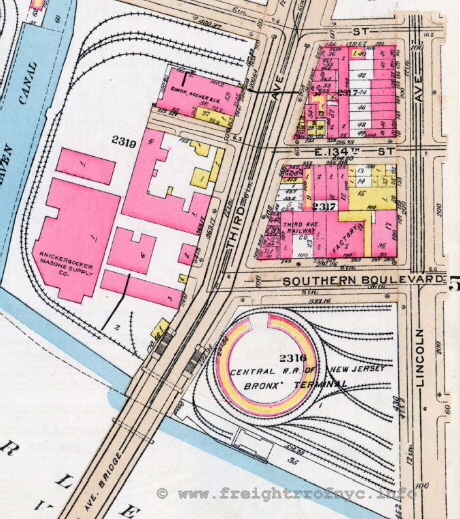
G. W. Bromley - 1928
.
.
For reference, it should taken into consideration that in close proximity to these four Harlem River "offline terminals", would be the New York Central Railroad's "Bronx Terminal Market" to the north, the previously mentioned New York New Haven & Hartford Railroad's "Harlem River" railyard directly to the south; and to the northeast, both the "Port Morris Yard" of the New York Central Railroad and "Oak Point" facility, of the New York New Haven & Hartford Railroad.
All of these facilities were connected to the mainland rail network and were not "off line", but only the New York Central "Bronx Terminal Market" and New York, New Haven & Hartford Railroad's "Oak Point" facility were equipped with float bridges and utilized carfloat service at their facilities.
The Central Railroad of New Jersey ceased operations at the Bronx Terminal facility on November 27th, 1961.
.
.
The following image, a Fairchild Aerial Survey Photo taken in 1924, shows the Central Railroad of New Jersey Bronx Terminal in its entirety. Even the engine house can be seen protruding over the water just south (below) the abutment for Third Avenue Bridge and directly above the float bridge. North of the bridge, a few tracks can be seen adjacent to the bulkhead.
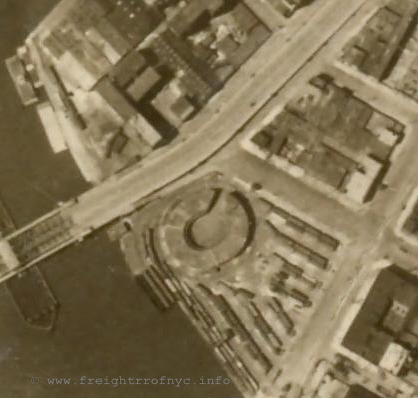
Fairchild Aerial Survey Photo - 1924
NYPL archives
.
.
One of most outstanding features of this facility would be the almost completely circular freight house with center courtyard for less than carload "LCL" shipments.
Three of the four offline terminals located in the Bronx (this Central Railroad of New Jersey Bronx Terminal, as well as the Delaware, Lackawanna & Western "Harlem Transfer" and the Lehigh Valley "Bronx Terminal" facilities), would feature circular freight houses, but none would be almost 360 degrees in circumference like this freighthouse would be. Only a narrow passageway for motor trucks would be left open.
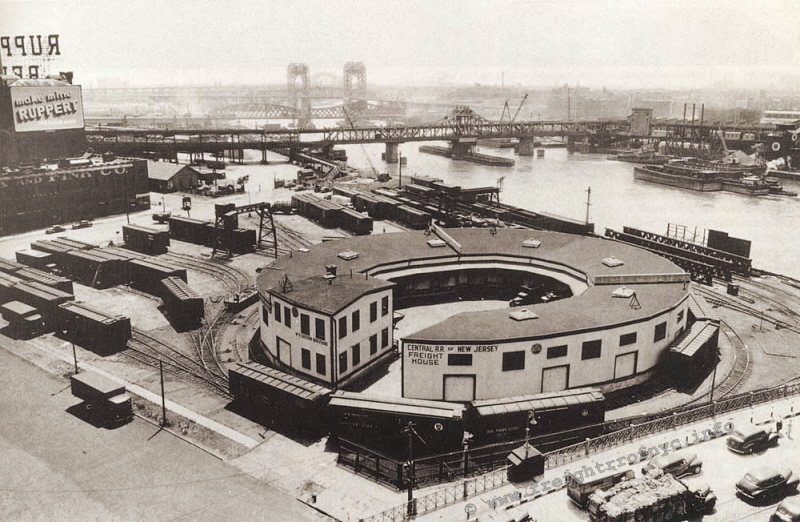
1944
unknown photographer
“Where Rails Meet the Sea" by M. Krieger
courtesy of T. Warris
.
.
Although the architecture was most interesting and very unique, the design was originally constructed for use with the small 36 foot wood boxcars of the early 1900's.
As freight cars construction developed and utilized steel, the boxcars became larger, progressing from the standard 40 foot boxcar to the 50 foot and eventually reaching the 60 foot or larger "double door" boxcars becoming common. As this occurred, the spacing of doors on the freight house (originally designed for 36 foot boxcars) would no longer be adjacent to the larger boxcars on the concentric trackage.
As these larger cars would have have to uncoupled and spaced apart to align the doors of the boxcar to the loading doors of the freight terminal which wasted a good deal of trackage space on the inner trackage circle. Therefore the design of freight house became impractical and more difficult to use as boxcars grew in size and capacity.
Also taking into consideration, the center courtyard became constricted as internal combustion motor trucks grew in size and capacity as well.
This facility would serve several diverse industries and utilizing a rail spur, would be an engineering facility of the Central Railroad of New Jersey.
In the 1942 G. W. Bromley Map, show below, we can the addition of a several tracks in the "north" or "new" yard, as well as the Weber Bunke Lange Coal Company. Also a track running east through block 2319 can be seen serving the Factory & Warehouse.
According to the legend on the Bromley map index, pink structures denote brick construction, yellow structures are wood frame construction, stone / concrete construction in light brown, and iron or metal sheathed wood construction is yellow with blue outline (i.e. pier).
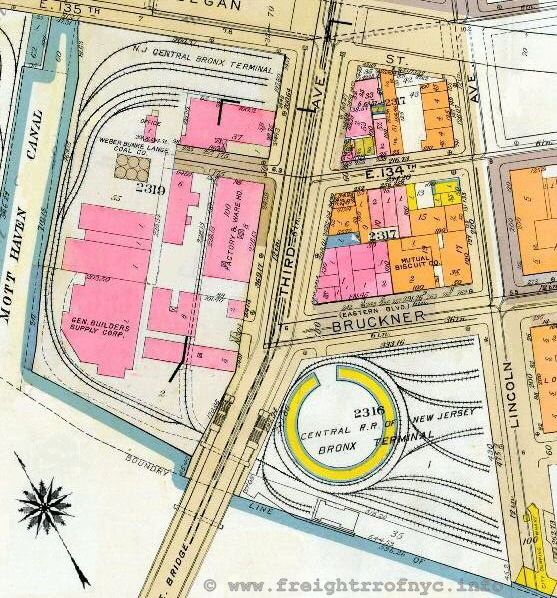
G. W. Bromley - 1942
.
.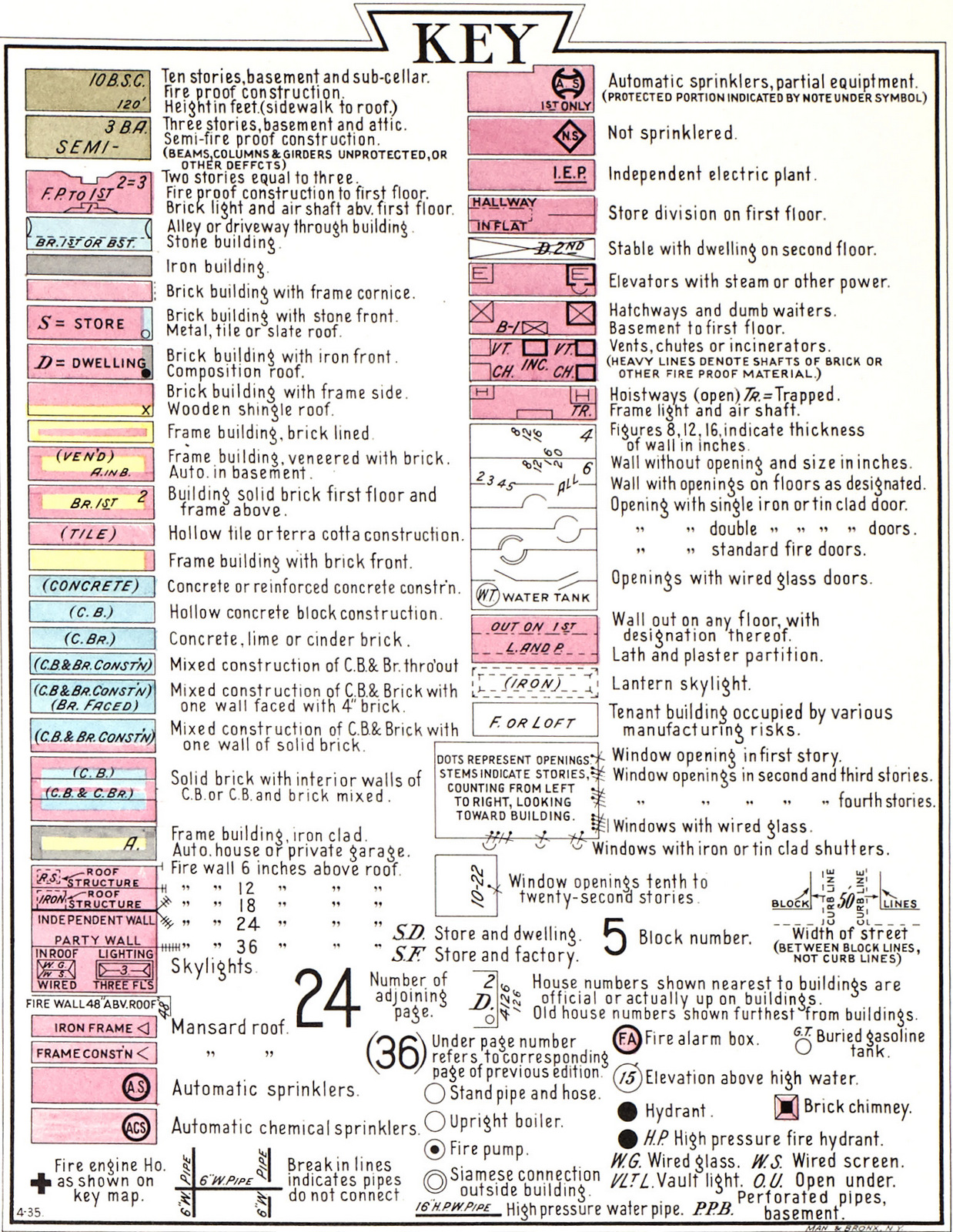
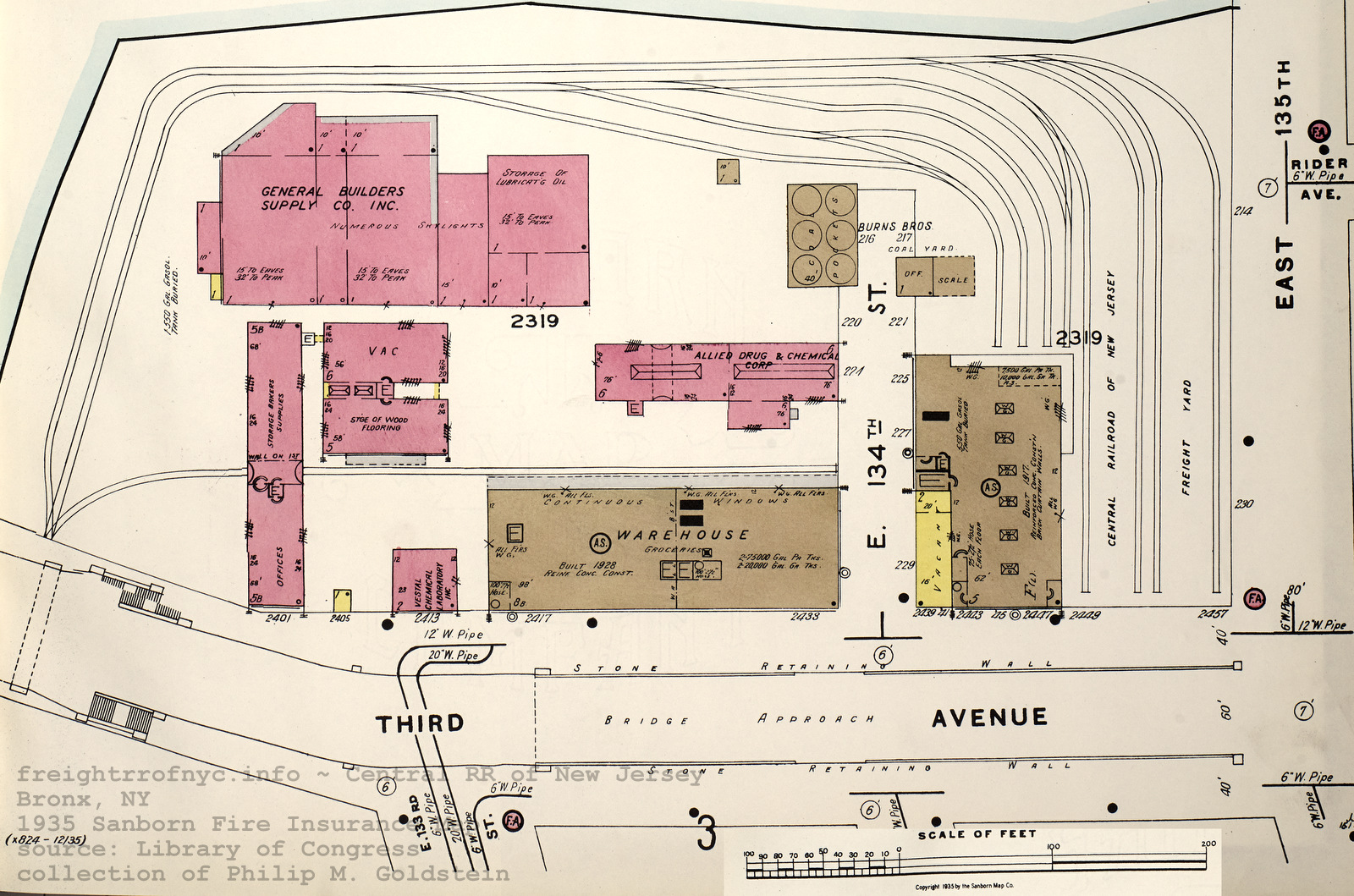 |
|
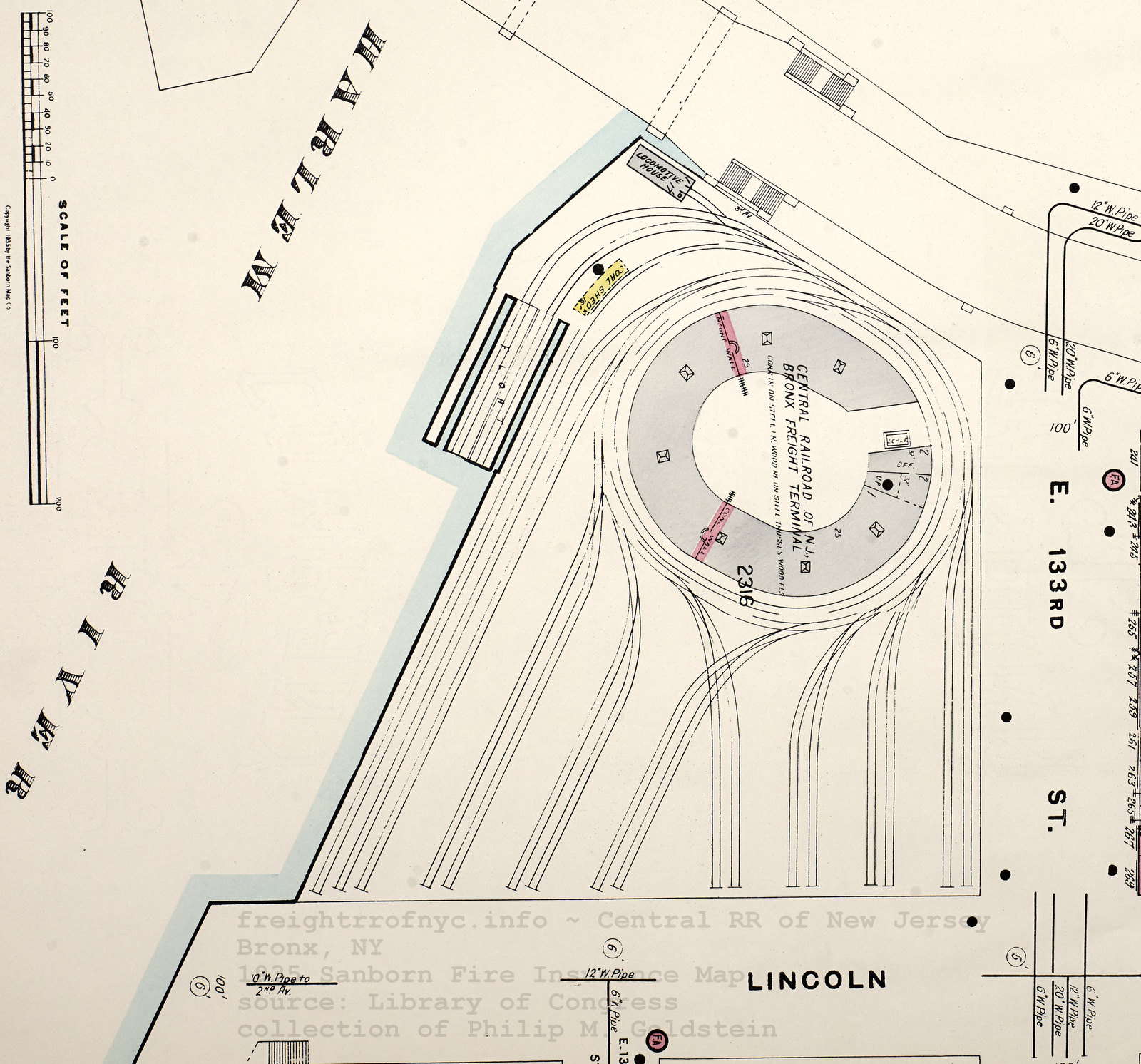 |
|
| Sanborn Fire Insurance Map - 1935 Library of Congress authors collection added 01 January 2023 |
|
| . . |
|
.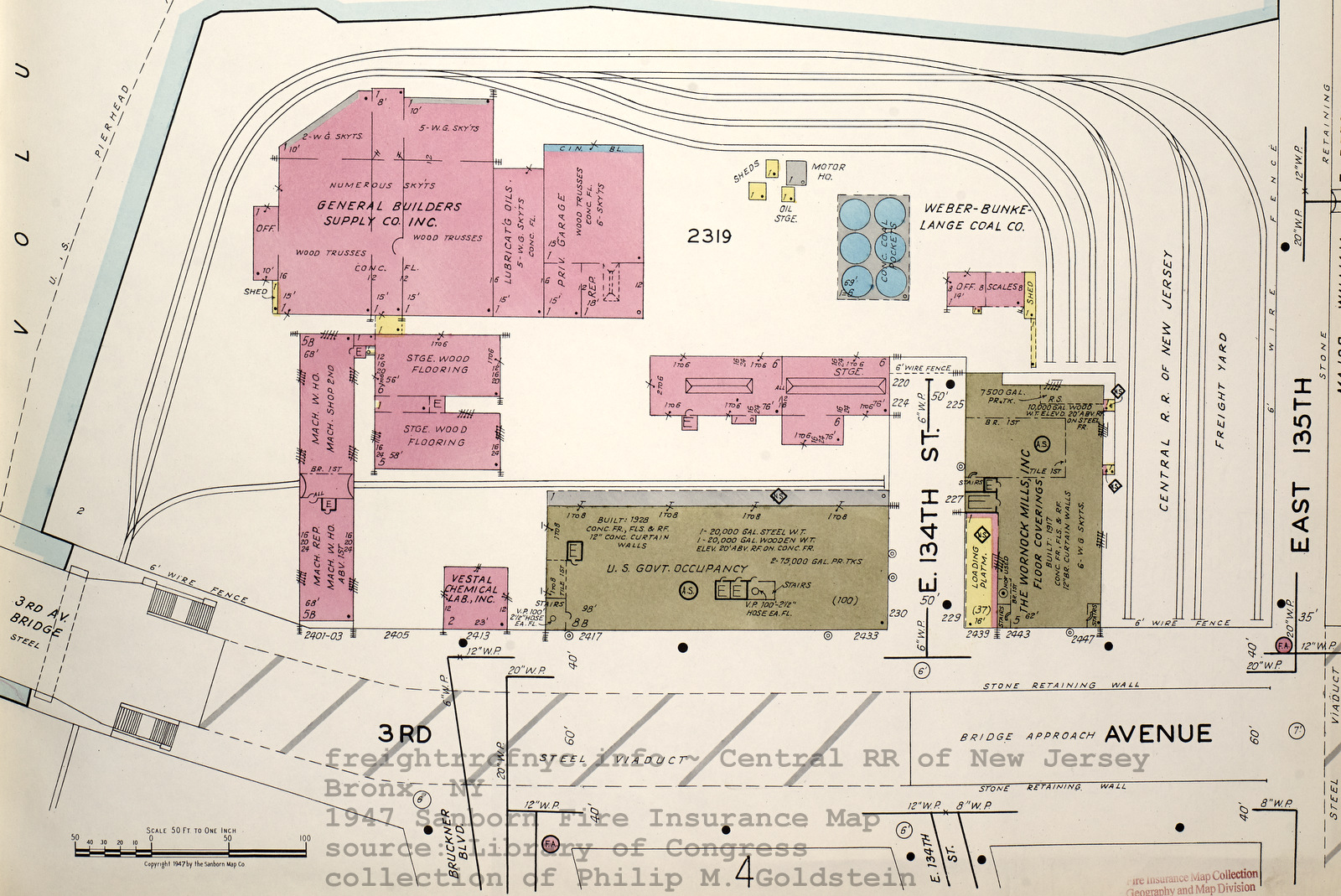 |
|
. 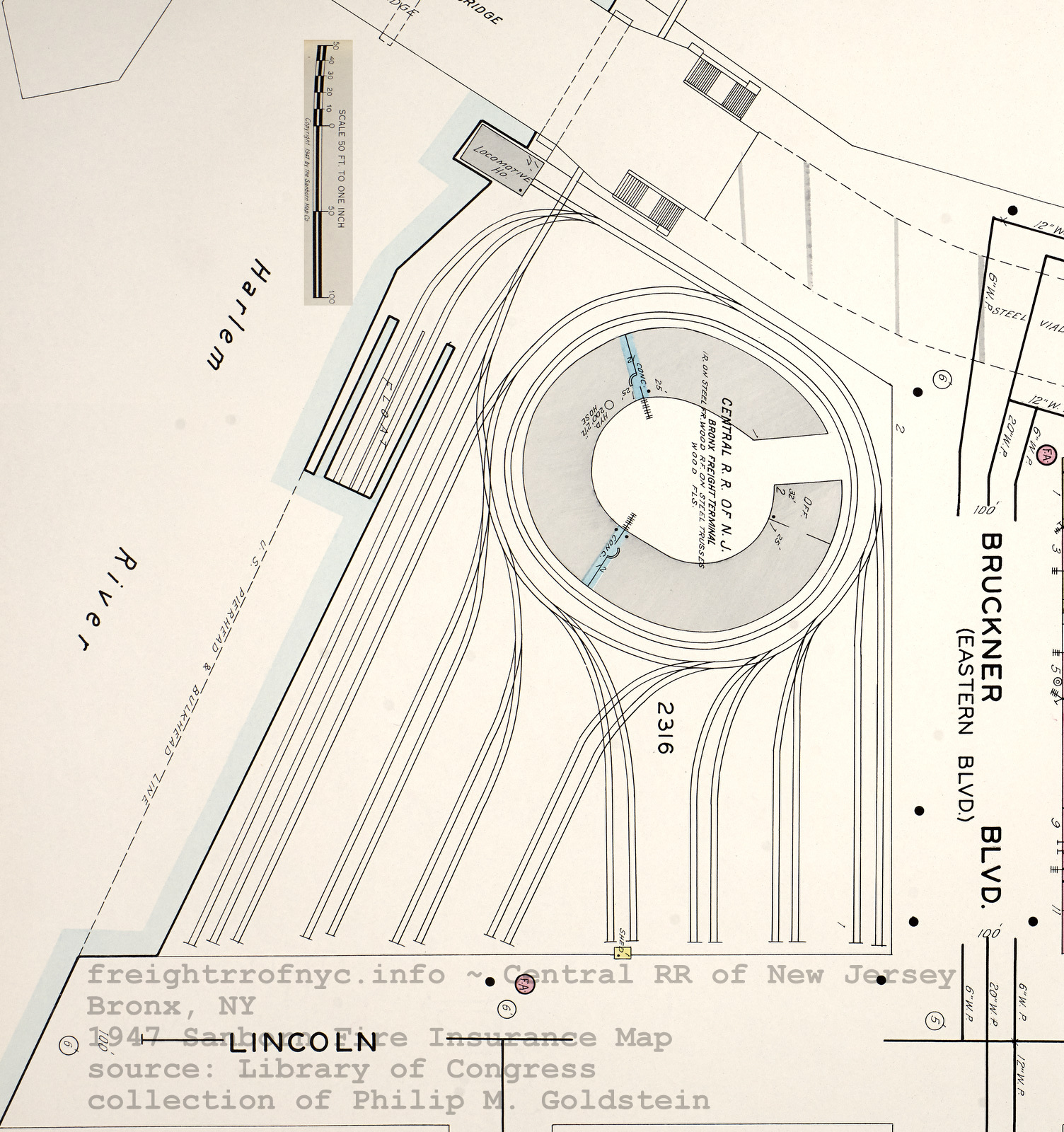 |
|
| Sanborn Fire Insurance Map - 1947 Library of Congress authors collection added 01 January 2023 |
|
| . . |
|
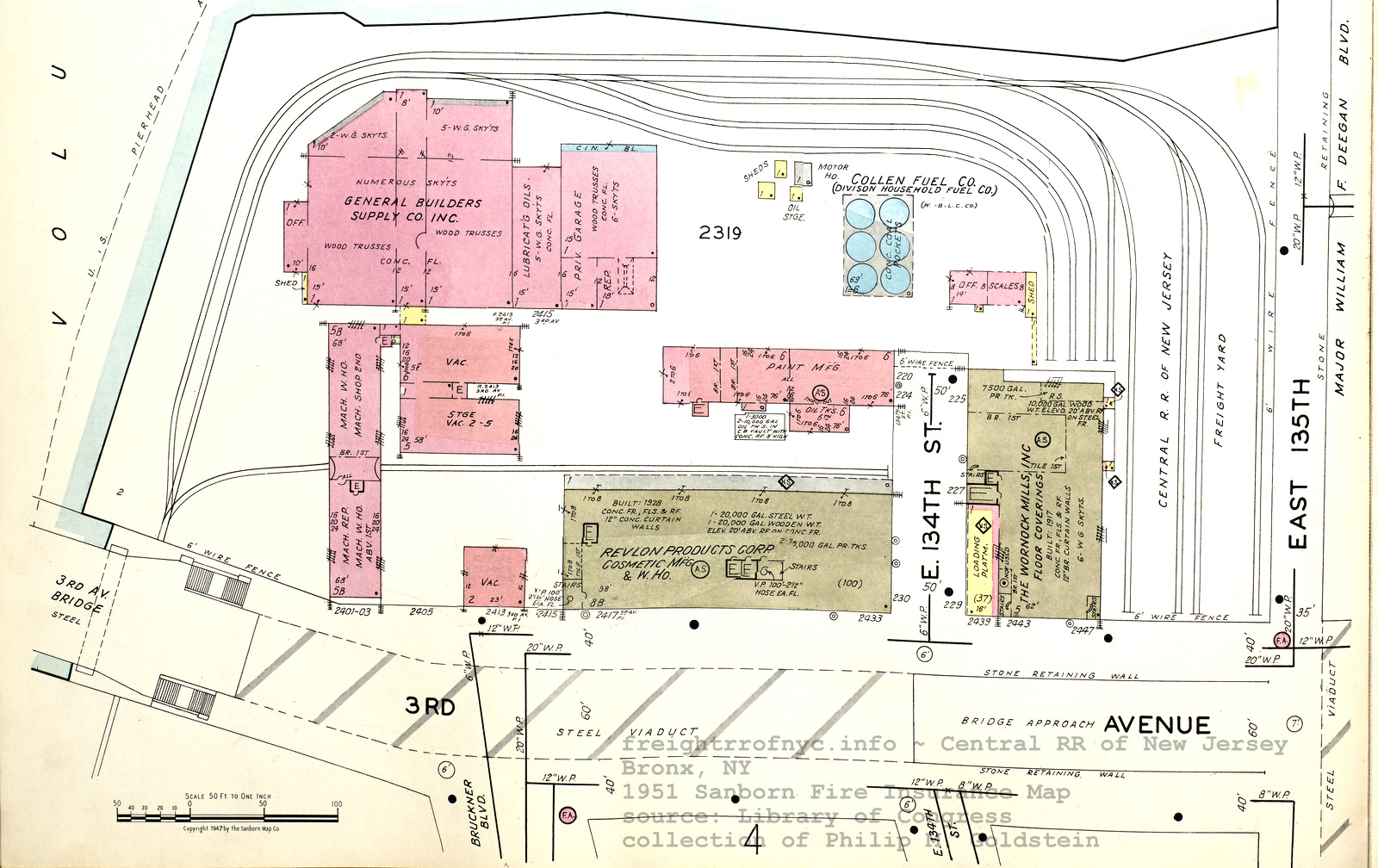 |
|
. .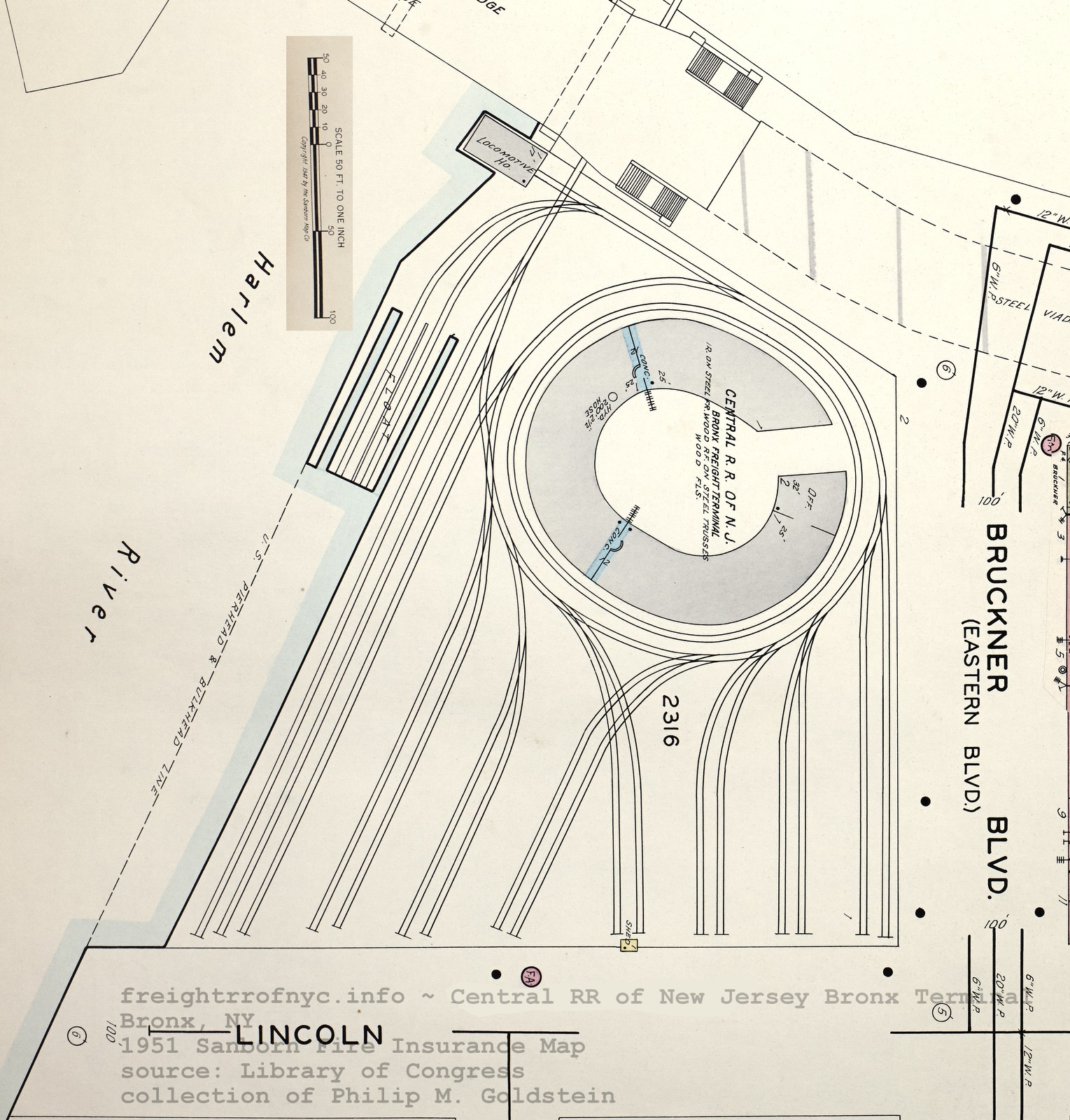 |
|
| Sanborn Fire Insurance Map - 1951 Library of Congress authors collection added 01 January 2023 |
|
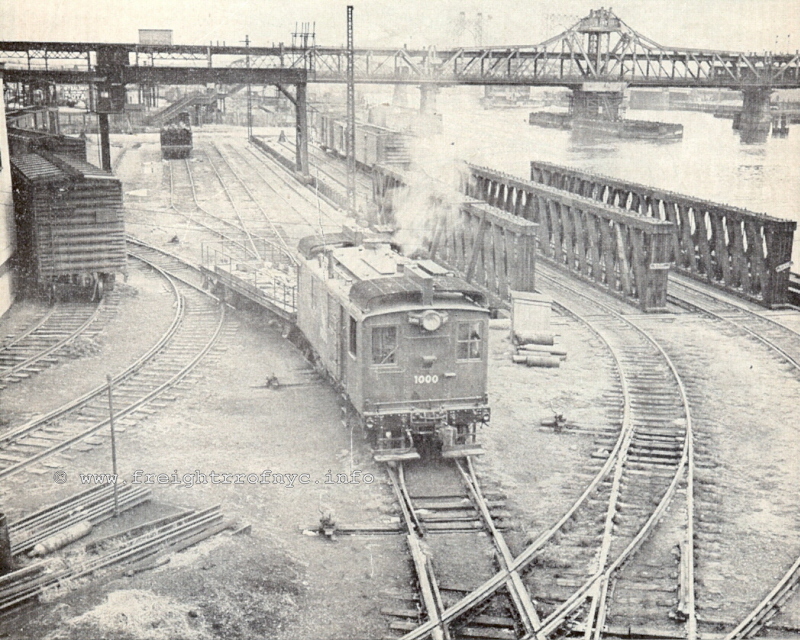
looking south from Third Avenue Bridge abutment - ca.
early 1950
(note the simple idler car)
A. Q. Vogel photo
Railroad Model Craftsman, February 1950
issue
.
.
.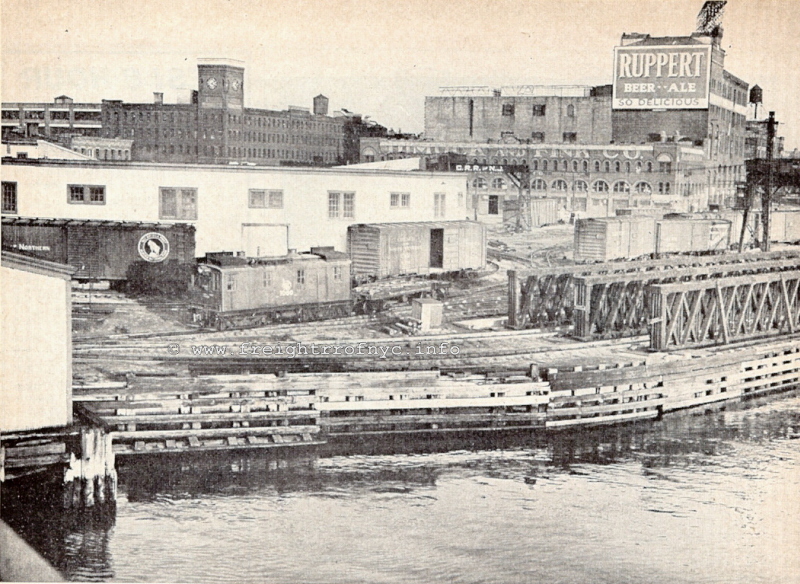
looking east from Third Avenue Bridge
(note corner of enginehouse on left of photo)
A. Q. Vogel photo
Railroad Model Craftsman, February 1950
issue
.
.
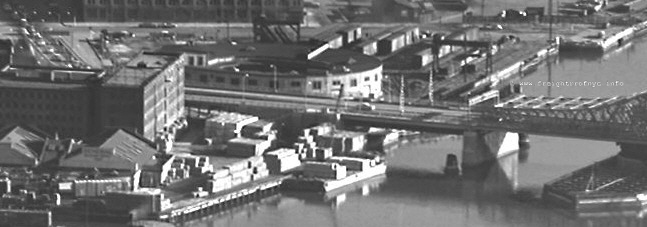
December 15, 1957
(looking southeast)
Fairchild Aerial Survey Photo
NYS Library Digital
Archives
added 15 May 2009
.
.
Tim Warris sent the following image to me on 16 February 2010. At this size, it is an "okay" photo showing an overall view of the bulkhead and property structures. However, upon clicking on the picture below will bring you to a large high resolution version which is substantially more rewarding! Use the back arrow on your browser to return you here.

unknown date
unknown photographer
courtesy of T.
Warris
added 16 February 2010
.
.
Then & Now
Tim Warris offered the use of his satellite image overlay on Bromley Map. It shows to a remarkable degree the changes that occurred to the bulkhead and property after the terminal had closed:
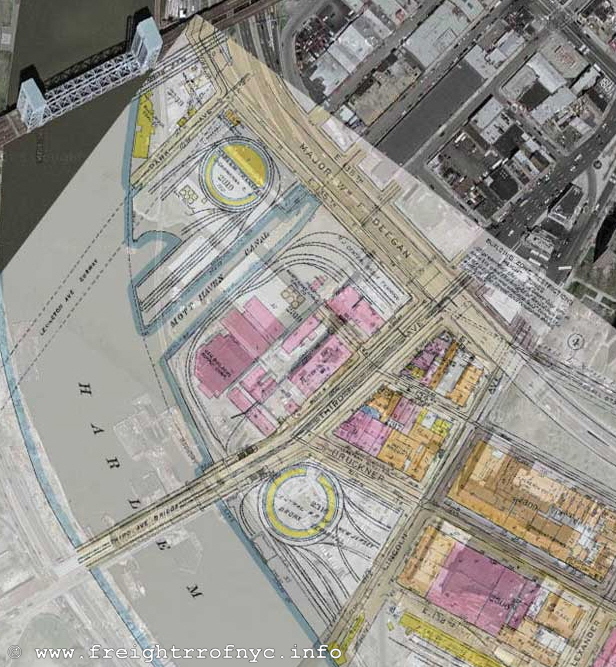
courtesy of T. Warris
.
.
The layout of tracks at this Bronx Terminal would be complex, yet remained largely unchanged during the existence of this facility.
Due to the constrictive nature of this facility, and like those of the neighboring off line terminals; the track design incorporated very tight radii trackage of 90 foot minimum and 104 foot maximum.
An abundance of "guard" rails was utilized to protect against derailments. This naturally added to the elaborate design, construction and appearance of the three-way switches, crossings and slip switches used at this facility.
Basically, the track plan consisted of two concentric circles of tracks completely encircling the freight house, with two turnouts on opposite sides of the freighthouse for greater versatility in spotting freight cars by the freighthouse doors. Two lead tracks from the float bridge merged into one track connected to the outer circle track.
While less than carload "LCL" freight would be spotted on the inner circle of track at the freighthouse, there were seventeen team tracks of various lengths to accommodate the offloading and loading for car load lots.
The were two overhead gantries at the Bronx Terminal facility: one over tracks 7 and 8 - the "east gantry"; and a slightly larger one located over tracks 15, 16, 17 - the "west gantry". The east gantry was fixed in place, however the west gantry was of a movable type, that ran on guide rail and could transverse the entire length of tracks 15, 16 and 17.
In the original version of the following image, the "crane rail" a/k/a gantry was shown, but the for some odd reason the west gantry itself was omitted. The author has rectified this omission.
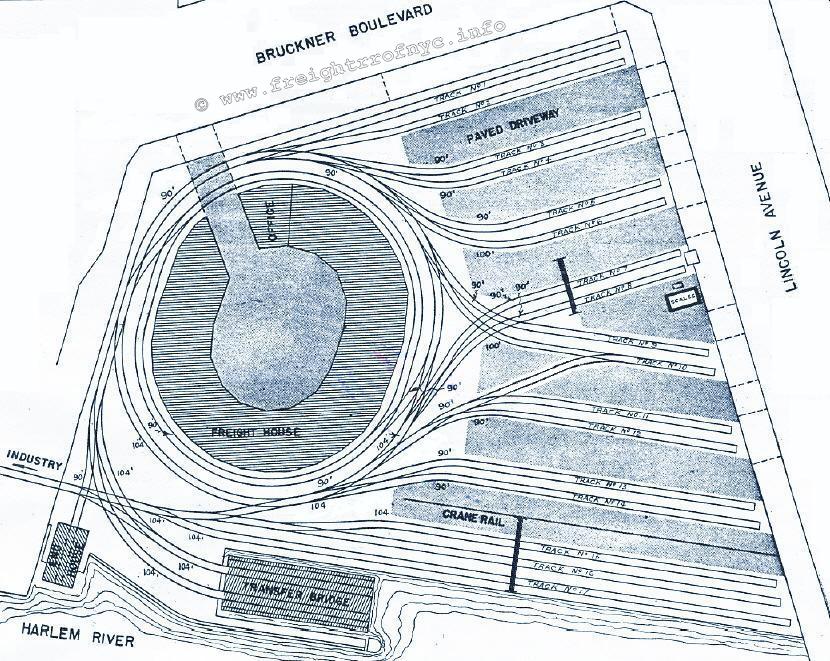
Railroad Model Craftsman, February
1950
.
.
Looking closely at the track diagram above, you will notice a diagonal track connecting track 11 with track 10. This track forms one leg of a "wye" (track 11 to track 10, track 10 to outer running track and outer running track to track 11) and will enable the crew to turn the locomotive around without the need for a turntable. This track is shown to be in place in this 1950 diagram, and the 1944 image at the top of this page. However, this track is not visible in the 1938 photo directly below. So, we have no exact date of when this wye track was officially added
The following image, was taken at an elevated position from Lincoln Avenue and is looking north at the facility.
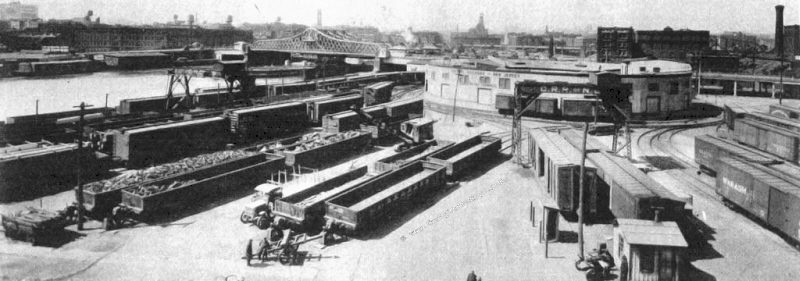
Reading - Jersey Central Magazine, 1938
courtesy of T. Warris
.
.
In 1929 (and possibly earlier), a substantial addition of yard trackage totalling 95 cars took place. This new yard would be built across Third Avenue northwest from the original property and a connecting track would be constructed under the Third Avenue Bridge approach ramp to access this new yard. The following image shows a portion of than new yard:
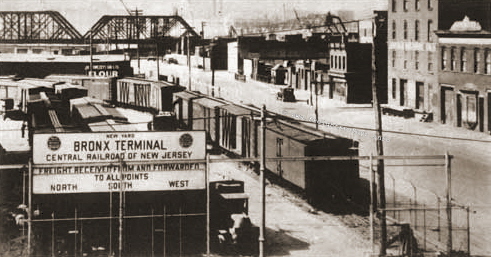
"New Yard" entrance at Third Avenue and East 135th
Street
Reading - Jersey Central Magazine,
1938.
courtesy of T. Warris
..
.
Eventually, an enginehouse would be constructed, partially on the bulkhead and partially on piles in the Harlem River prior to 1924. This enginehouse can be seen in the background of the following image. It is the white structure with two windows directly behind the two right most strings of freight cars. Also visible in this photo is the west gantry (extreme right of photo).
This image also shows one of the tugboats specially modified for Harlem River use. Note the short pilot house and smokestack. The reasons for this design were to allow the tugboat to sail under the several low clearance swing bridges spanning the Harlem River, without the need for them to "open up" and tie up vehicular traffic. While we can see the Central Railroad of New Jersey herald on the stack, we unfortunately cannot determine which tugboat it is.
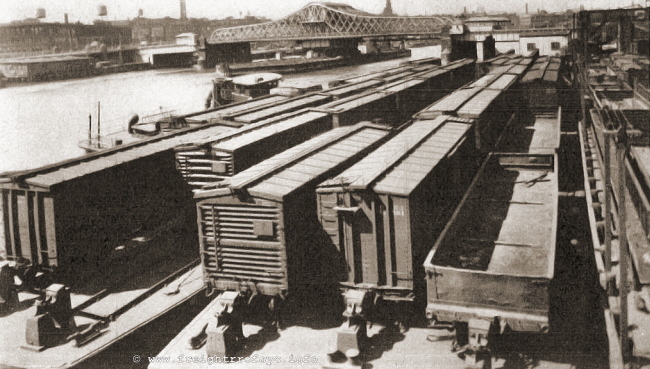
Harlem River Bulkhead
Reading - Jersey Central Magazine, 1938
courtesy of T. Warris
.
.
The Unique "Removable Crossover" and "Quad Diamonds"
Much of the track work at this facility was complex and extremely condensed, making it very unique in the normal operation of a terminal. The track work at this facility incorporated several three-way curved switches, diamonds, a wye, and tight curves with a minimum of 90 foot and a maximum of 104 foot radii.
But, the two most outstanding features of this track work that would stand out is the "Removable Crossover" and the "Curved Quad Diamonds".
.
Removable Crossover
The method of accessing the enginehouse was of a most unique design. There were removable steel stock inserts used to cross over the switchpoints of the running tracks and to access the enginehouse lead track.
The reason for this unusual method was that the track work at this facility was so complex, that the rails to the enginehouse were designed and constructed to be removable, so they would not foul the points of a turnout on the running tracks that was located perpendicular to and in front of the enginehouse.
These steel inserts would only be temporarily laid in place over the turnout in front of the enginehouse, when the locomotive would need to be stored. After the locomotive was brought out of the enginehouse for the start of the days operations, the inserts would be removed and simply laid between between the rails for ready use.
As there would be only one locomotive ever in use at this facility, there was no danger of another locomotive that could be using the running tracks of hitting the steel inserts.
|
|
The image on the left, was taken from the abutment of the
Third Avenue Bridge, and almost directly over the tunnel leading to the northern
part of the property.
This photo clearly shows this unique track arrangement,
If one looks carefully at the left image, in between the tracks
There were two inserts for each rail, for a total of four pieces.
Judging from the images, the dimensions of the steel inserts
|
| I have retouched the image at right, to represent what it
would look like with those steel inserts in place.
This would allow the locomotive to pass over the turnout and
As far as can be ascertained, the Central Railroad of New Jersey Bronx Terminal was the only facility in the New York area (and possibly the United States) to utilize this method. |
|
.
.

close up of the removable steel segments
.
.
|
|
.
.
"Curved Quad Diamonds"
Also of a unique nature to this offline terminal, would the "curved quad diamond" track structure leading to the four centermost tracks in the yard. While one would see multiple diamonds when two or more multiple main lines crossed one another or in a large trunk line classification yard; having a curved quad diamond in a small rail terminal would be most unusual. Especially so, when each one of the diamonds were of a different radius!
While tangential (straight) quad diamonds might have been simple in construction, theis curved variety were certainly not, and not to mention being most unusual in their application.
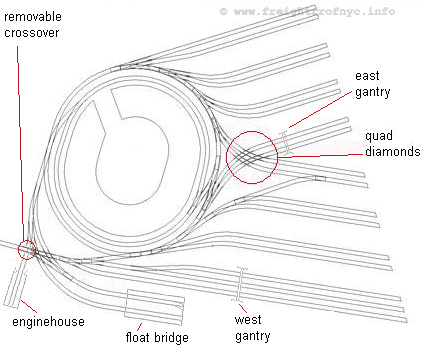
original track plan courtesy of T. Warris. Modified
by author
.
.
According to a multi-page article in the February 1950 issue of Railroad Model Craftsman, no freight cars would be carfloated from Central Railroad of New Jersey facilities in New Jersey, to the Bronx Terminal without the dispatcher's telephone confirmation of available track space at the Bronx Terminal.
Only then would a carfloat and tugboat be dispatched to bring freight cars to the Bronx Terminal. Any freight cars that could not be accommodated at the Bronx Terminal, were stored at the Central Railroad of New Jersey's Jersey City facility.
Following the decline of rail marine traffic in the New York City area, the original yard trackage would be reduced in 1959 to utilize the three team tracks nearest the bulkhead. These three tracks would remain to so freight may be accessed by the gantry.
.
.
The float bridge(s) located at the Bronx Terminal was of a pontoon type wood Howe Truss style.
Actually, over the course of the history of the Bronx Terminal, there were two wood Howe Truss float bridges. The original float bridge was in service from 1907 to 1920. At this time it was replaced with another wood Howe Truss float bridge which served until closure of this facility. Please note, there would only be one float bridge located at this facility at any time.
Appearing in a Railway Age article dated May 21, 1920; this replacement float bridge was constructed by a new method:
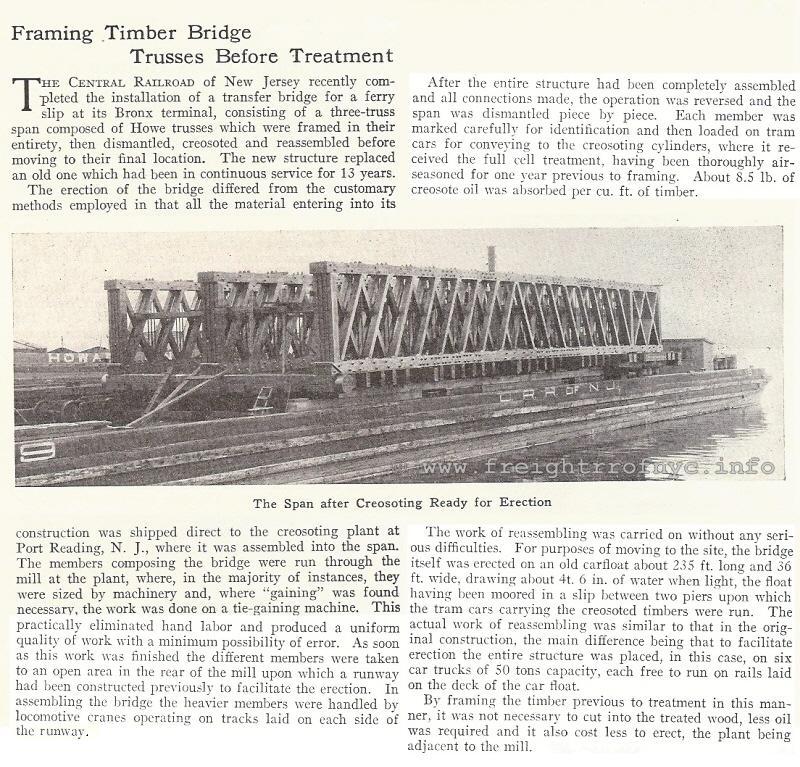
Railway Age - May 21, 1920
authors collection
added 30 Jan 2009
.
.
This second or replacement float bridge appears in several photos taken at later dates, and it is most likely that this float bridge remained in service until the closure of this facility, never having been replaced with a more modern steel design.
Once a very popular design of float bridge, not many of this type of float bridge survived through to the latter half of the twentieth century, having been replaced with float bridges of steel construction.
In the New York Harbor area, the only other float bridges of Howe Truss design known to have been used by locations discussed on this website, and after 1950, were at the Pennsylvania North 4th Street Freight Station and the Baltimore & Ohio West 26th Street Yard.
Sadly, only the West 26th Street Howe Truss float bridge has survived, but fortunately it has been restored and is now part of a linear park on the West Side of Manhattan, and is a public kayak launching station.
The following image (taken from the photo near the top of this page), shows the Howe Truss floatbridge nicely:
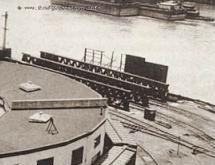
.
Note the large billboard on the bulkhead between the float bridge and Harlem River (which is already partially fallen down) in the photo above. Thanks to an image sent to Tim Warris, we now know what the billboard said:

Billboard mounted on bulkhead in front of floatbridge - unknown
date
courtesy of T. Warris
added 16 February 2010
.
.
.
#840 - 0-4-0T
The steam locomotive known to have been used at this location would be Central Railroad of New Jersey #840. This locomotive was built by Baldwin Locomotive Works in 1907 and was of 0-4-0T (side tank) wheel arrangement.
However, the Central Railroad of New Jersey owned several other and older tank locomotives #1 (0-6-0T), #11 and #14 (both 0-4-0T) around the year the Bronx Terminal was opened, so there is a possibility that one or more of these other tank locomotives operated at the Bronx Terminal when #840 needed servicing.
#840 would serve this location until 1925. This coincided with Ingersoll - Rand's development of an diesel - electric locomotive suitable for yard and switching work.
You can read the comprehensive history of all steam locomotive restrictions for the City of New York, beginning 1834 and ending with the Kaufman Act and its repeal on the main page of this website: Steam Locomotive Regulations within the City of New York. It is very much worth a read, because there are misconceptions about the Kaufman Act, i.e. such as it was repealed in 1930.
Following the arrival of #1000, #840 was then used for enginehouse
service at the Communipaw, NJ shops of the Central Railroad of New
Jersey.
.
#1000 - Making Diesel-Electric Locomotive History!
The second locomotive used at this facility would be Central Railroad of New Jersey #1000.
This locomotive was of American Locomotive / General Electric / Ingersoll Rand construction, and was a 300 horsepower boxcab. #1000 began service at the Bronx Terminal on October 22, 1925. It would spend more than thirty years serving at this location and this unit would be classified by the Central Railroad of New Jersey as either a SD-3 or a D3-O throughout its history.
One of the reasons this locomotive was assigned to the Bronx Terminal; was that in 1923 the "Kaufman Act" was ratified, and with that Act the City of New York attempted to ban the use of steam locomotives within city limits. This Act is covered in depth and great detail on an associated page of this website: Steam Locomotive Legislation, Regulations and Restrictions in and around the City of New York.
As a result of this legislature, the railroads approached General Electric and Ingersoll Rand. After extensive testing, GE / IR Demonstrator #8835 proved that diesel-electric locomotive had come of age and were well suited for yard switching. By the conclusion of testing, the Kaufman Act was ruled unconstitutional in 1926 and repealed; but the die had been cast: the diesel-electric switching locomotive was more economical, easier to operate as well as more environmentally friendly, both from the standpoint of pollution as well as a nuisance factor.
And so, this diesel-electric configuration was put into production. This very Ingersoll-Rand diesel-electric locomotive would be the trend setter for railroads within the New York City limits to convert to internal combustion powered locomotives, which helped make this locomotive the first successful commercially sold diesel-electric locomotive. It is ironic how another of New York's offline terminals: the Jay Street Connecting Railroad, would have the honor of receiving the first diesel electric locomotive, but unfortunately this locomotive was not successful.
Stated in the December 1970 issue of "Trains" Magazine, the CNJ #1000 transported itself from the Phillipsburg, NJ construction facility of Ingersoll-Rand to Elizabethport, NJ yard of Central Railroad of New Jersey. The first 100 days of operation of this locomotive cost the Central Railroad of New Jersey $301.
By comparison, the last 100 days of steam locomotive use cost Central Railroad of New Jersey $1420. Factors involved in this expense reduction in using a diesel locomotive were: fueling effort (a small fuel pump compared to shoveling coal), almost no water usage, no ashpit cleaning labor, no overnight engine watchman labor, and less time involved in start up. Is it any wonder the diesel locomotive unseated the steam locomotive so quickly?
"By the way, CNJ #1000 was NOT a "diesel-electric" (not then, anyway); she was referred to as an "oil-electric".
The reason for this being Rudolph Diesel was a German and anti-German sentiment following World War I was still running very high in the early Twenties;
so Ingersoll-Rand called their compression ignition engines "oil engines".
Sam Berliner
Never the less, the boxcab diesel (oil) - electric locomotive became a huge success and helped usher in the era of diesel-electric locomotives (and unfortunately ushered out the era of the steam locomotive).
According to an account by N. W. James, Director of Publicity for the Central Railroad of New Jersey; #1000 would be overhauled and repainted in "deep sea green" color and the Jersey Central Lines "Miss Liberty" logo and lettering applied in yellow, during 1947.
In June of 1957, this locomotive was retired and due to its
significant history, it subsequently went to the Baltimore & Ohio Railroad
Museum in Baltimore, Maryland, where this locomotive is now an
exhibit.
.
#1023
The third locomotive to be used at this location would be Central
Railroad of New Jersey #1023. This locomotive was an HH600 (High Hood 600
horsepower) built by American Locomotive Company. This locomotive required
a modification consisting of extended couplers to cope with the sharp radii
of the Bronx Terminal trackage. This locomotive was not in use at this facility
for long.
.
#1001
The fourth and final entry in the locomotive roster would be a Davenport 35 Ton locomotive. It was acquired used from the US Army and this locomotive would become Central Railroad of New Jersey #1001. Some accounts at my disposal list this locomotive to be a gas - mechanical, while others show it as diesel - mechanical.
On 08 September 2010, I received an email from Alton Underwood who offered the following information:
.
I was just on your great site about the terminals and saw one tiny mistake on your Bronx Terminal Locomotive Roster: #1001 Davenport 35 ton unit was a diesel electric. My Davenport data shows this unit was one of a batch of five built Sept., 1941 for the Corps of Engineers (#3502, Atlanta Ord. Depot, transferred to USATC as #7215 at the same location). They all had Cummins L diesel engines in them.
So with thanks to Alton, I have amended the information here to reflect that data.
As far as can be told, this locomotive operated at Bronx Terminal from 1952 to at least 1958 (that date of the 16mm film below), and in all likelihood, through closure of the facility in 1961.
It became standard practice to transport this locomotive by carfloat to and from the Bronx Terminal from the Central Railroad of New Jersey's Communipaw roundhouse on the first and last carfloats of the day. It is understood that this was not so much due to cost saving measures as it was due to the economic and social decline of the inner city.
As such with most of the Bronx, particularly the industrialized areas bordering the Harlem River, they had become plagued with crime and vandalism and of which had become commonplace. As a result of this, and without the locomotive being housed at the facility any longer, the enginehouse was no longer needed and was razed.
Contradictory to this information, the Robert Hart film clearly showes #1001 "parked" on one of the outer loop tracks. As this video was taken on a Sunday (March 30, 1958), it is highly doubtful there was operations on that day. Not to mention, it should be have breen loaded on athe last westbound carfloat back to New Jersey at the conclusion of the previous work day's switching.
Just as obviously, it is not stored in the enginehouse (which has presumably been raised by time of the video). My point is, if railfans are in the yard taking movies, then vandals can also gain access to the yard. So why would the locomotive be left at the terminal unsecured and not brought back to Communipaw at the close of business of the last work day?
With this film, it now remains to be confirmed whether CRRNJ really did transport #1001 to and from the Bronx, or was this video taken on a rare occasion where the locomotive was left on property.
.
.
This video was a originally 16mm (no sound) taken by Bob Hart on Sunday, March 30, 1958. I met Mr. Hart at the Clark, NJ "Mother Seton H.S." Train Show on 06 March 2011, and he informed me he had this footage. Mr. Hart mailed me the DVD and I received it 15 March 2011.
While it is not an "action" film, it does show #1001 (Davenport Diesel Electric 35 Ton ), trackwork freight house and float bridge!
.
.
|
|
| .
. |
|
|
| .
. |
|
|
| .
. |
|
|
| .
. |
|
|
| .
. |
|
|
| .
. |
|
|
| .
. |
|
|
| .
. |
|
|
| .
. |
|
|
| .
. |
|
|
| .
. |
|
|
| .
. |
|
|
| .
. |
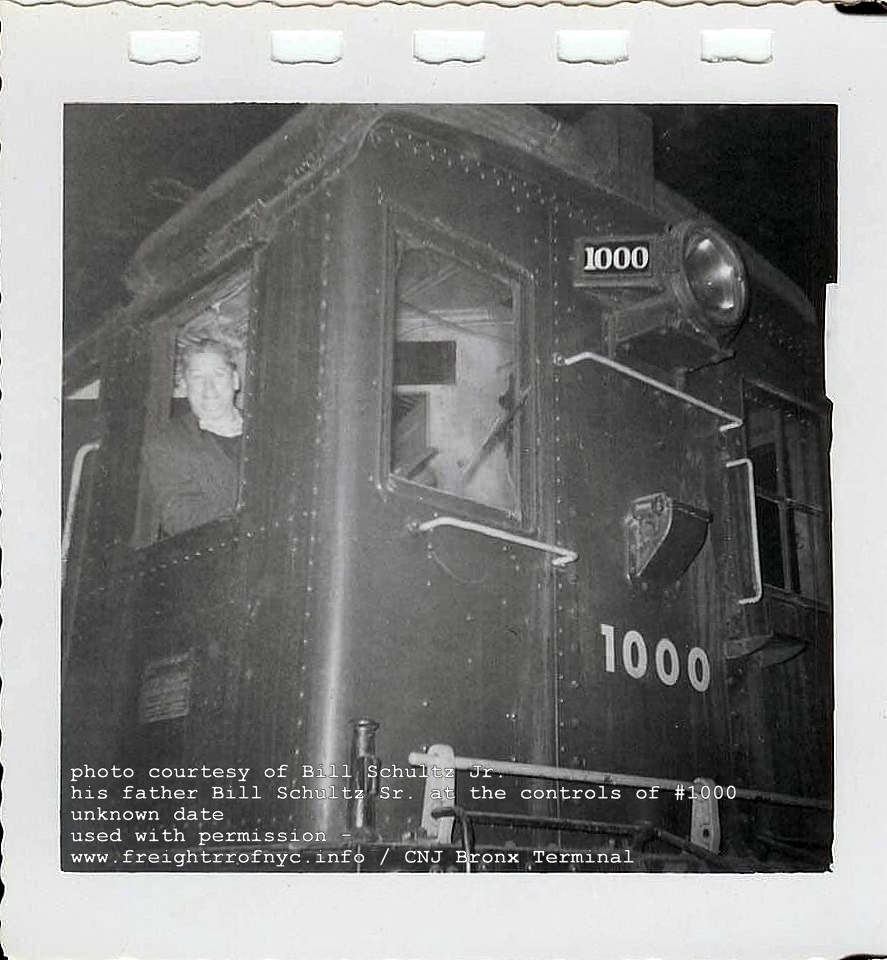 #1000 - unknown date Bill Schultz Sr. at the controls Bill Schultz Jr. photo added 19 August 2020 |
| .
. |
|
|
| .
. |
|
|
..
.
Bronx Terminal (CRRNJ)
Locomotive Roster
| number / name | builder | c/n | build date |
gauge |
wheel arrangement |
model | driver dia. |
cylinders |
acquired |
location |
disposition |
notes | ref |
| #840 | Baldwin | 29776 | 1/1907 | std. | 0-4-0T | 45" | 17" x 24" | new | sold for scrap 8/1954 |
side tank in service Feb 7, 1952 |
[2] | ||
| #1000 | ALCo/ GE / IR |
65979 /9681 |
5/1925 | std. | B-B | 60 Ton boxcab | new | display B&O RR Museum | diesel electric, 300 h.p. B3-1 body type |
[1] [20] |
|||
| #1023 | ALCo | 69075 | 12/28/1938 | std. | B-B | HH600 | new | sold 12/1966 to Schiavone Bonomo, Jersey City, NJ |
modified with extended couplers | [1] | |||
| #1001 | Davenport | 2332 | 9/1941 | std. | B? | DE35 | used 8/1952 US Army #7215 (ex #3502) |
scrapped 9/19/1963 | 35 Ton - 275 h.p. diesel - electric Cummins L |
[5] |
.
.
. The Central Railroad of New Jersey had several tugboats on their marine roster. Four of these tugboats are known to have serviced the Bronx Terminal. These four vessels were of Bowes design, but in an internet search; only one of these, the "Sandy Hook", had been listed as having a low profile wheelhouse and smokestack for Harlem River use.
Research by Paul Strubeck however, reveals that all four of these tugboats were of low profile design, and all four were capable of navigating the Harlem River without requiring the swingbridges to open. Images of these vessels since acquired confirms this.
Pertaining to the low wheelhouse design, Charles Gerow, a New York Harbor Pilot (retired) based out of Sandy Hook, offered this explanation:
"the [lower] tugs were used NOT to avoid impeding road traffic, but to avoid being hung up by an obstinant draw tender, particularly if you had a fair tidal current pushing you."
This explanation makes good sense too as it would not be well off for the tug crew (or the bridge tender!) to hit the drawbridge.
The following image shows the easily recognizable differences between a "Harlem River" tugboat (below left) which could navigate the Harlem River without requiring bridges to open, as opposed to a standard profile railroad tugboat (below right) which could not:

.
.
It should also be noted that railroad terminals located along the Harlem River were imposed with physical restriction on the transport of carfloats. One must consider the narrow width of the channels between the swingbridge center island fender and end abutments. Therefore any tugboats transporting carfloats to any of the terminals located in the Bronx, would have to transport those carfloats singly.
|
|
| .
. |
|
|
| .
. |
|
|
| .
. |
|
|
| .
. |
|
|
| .
. |
|
|
| .
. |
|
|
.
.
Bronx Terminal (CRRNJ) Marine Roster
|
|
||||||||||||||||||||||||||||||||||||||||||||||||||||||||||||||||||||||||||||||||||||||||||||||||||||||||||||||||||||||||||||||||||||||||||||||||||||||||||||||||||||||||||||||||||||||||||||||||
Tugboat Footnotes:
| propeller diameter: | 8' 8" |
| ahead to astern clutch time: | 6 seconds |
| rudder to rudder hard over: | 15 seconds |
| fuel capacity: | 35,900 gallons |
| lubricating oil capacity: | 600 gallons |
| potable wate capacityr: | 2500 gallons |
| main engine: | Fairbanks 38D 8 1/8 |
| cylinders: | 10 |
| auxilary generators: | Fairbanks Morse 49A 40kw (x2) |
In discussion with Tom Flagg, is the design of the four Bowes tugboats. All four appear to have the same dimensions as well as low profile wheelhouse and stackheight, which would make all four vessels suitable for Harlem River use.
Vessel specifications from Bill of Sale of Enrolled Vessel and Port of Registry documents below.
Disposition data courtesy of Paul Strubeck research.
.
.
.
On Sunday, 07 March 2010, I attended the Clark / Mother Seton HS Train Show held in Clark, NJ; and hosted by the Central Railroad of New Jersey Historical Society. This is one of my favorite gatherings as it is centrally located for those persons instrumental to my research in New York Area Offline Terminals, and of whom make every attempt to attend. This year myself, Joseph Roborecky, Paul Strubeck, Tom Flagg, Jay Held, Ben Schaeffer, Gene Collora (who is a vendor as well) were in attendance.
Other than schmoozing, I have found that this show brings me good luck, and often I come across some good "tidbits". This year was not to be a disappointment either. After visiting my "regular vendors" (Gene Collora & Bob's Photos) for images, I commenced in browsing the other tables. One particular vendor was selling large quantities of official / internal documents of the Central Railroad of New Jersey.
What led me to look through these boxes I can't say, but something did. Imagine my joy when found the original (as it is written in blue ink) "Bill of Sale of Enrolled Vessel" for the CRRNJ tugboat "Sandy Hook" (a Harlem River boat) as well as first generation copies of the "Designation of Home Port of Vessel" and "Declaration of Ownership" forms for both the "Sandy Hook" & "Sound Shore" - another Harlem River boat and sister to the Sandy Hook!
These documents appear to be original copies (xerographed) by CRRNJ; as the staples are rusty and the paper has a yellowish and glossy tinge to it. Also, I came across modern copies of the Tug Reports for various work shifts dated January 1st through January 8th, 1964 for the "Communipaw", yet another sister to the "Sandy Hook" and "Sound Shore". All in all, the stack of documents (about ¾ of an inch thick) set me back a whopping $10!
Perhaps the most valuable information to be ascertained from this acquisition, are the vessels "official numbers", dimensions and weights. This information has been added to the Marine Vessel Roster above.
|
Bill of Sale of Enrolled Vessel - "Sandy Hook" |
 |
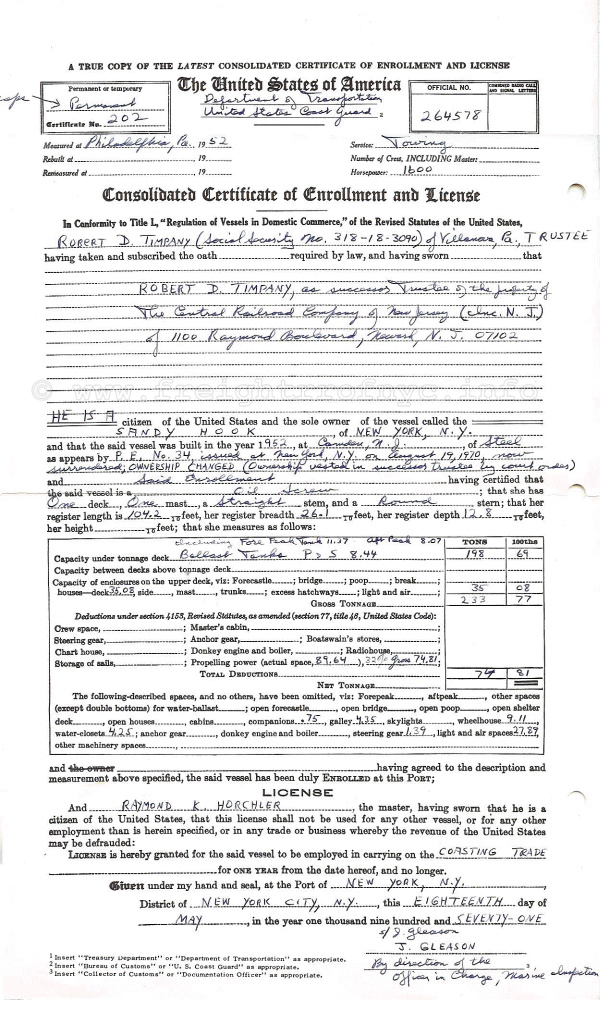 |
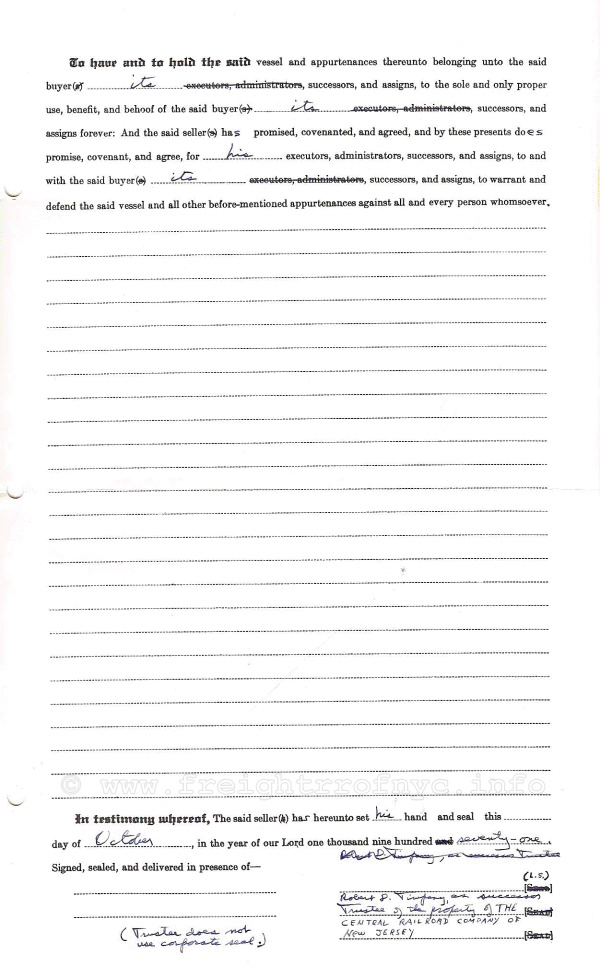 |
 |
| .
. |
|
Designation of Home Port of Vessel - "Sandy Hook" |
|
|
|
Ownership of Vessel Declaration - "Sandy Hook" |
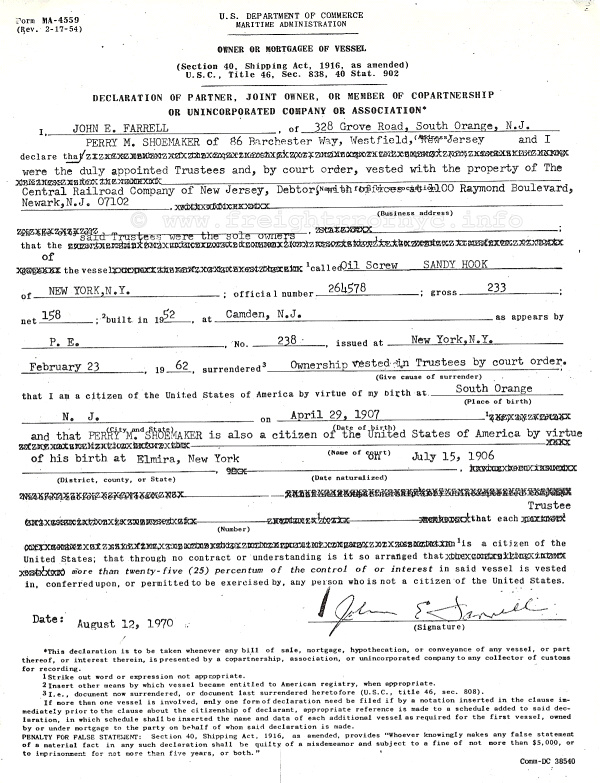 |
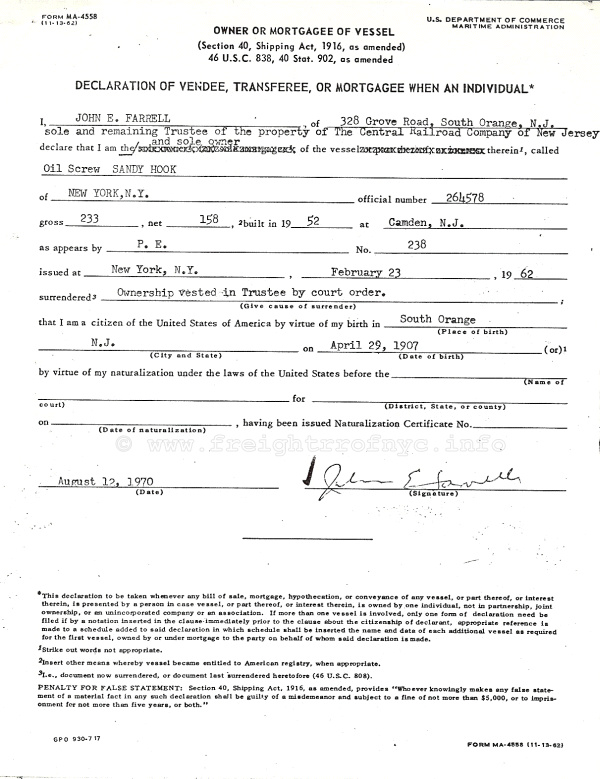 |
| .
. |
|
Designation of Home Port of Vessel - "Sound Shore" |
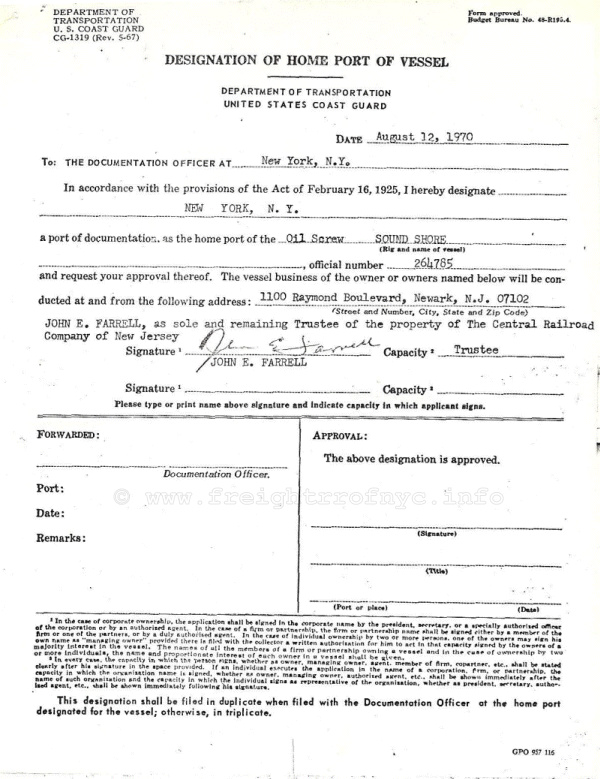 |
|
Ownership of Vessel Declaration - "Sound Shore" |
|
|
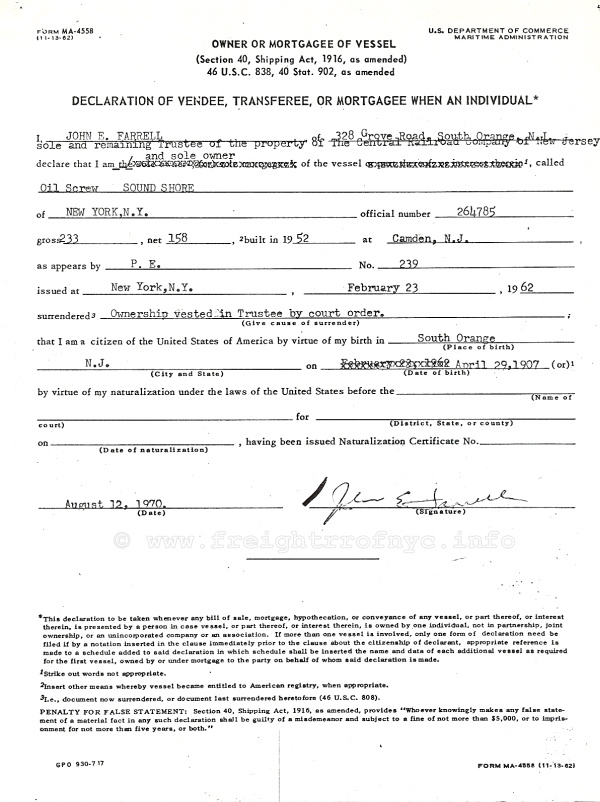 |
|
all douments above |
When it comes to modelling this unique offline terminal, Tim Warris' efforts stand above all else.
Tim has invested a significant amount of time and effort in recreating the trackwork at the CRRNJ Bronx Terminal. Tim recently shot some high definition video of the operation on his layout. I highly recommend those that are interested in modelling visit this link to view his efforts thus far.
Click on the image below to view. Use the back arrow on your web browser to return you here:
.
.
.
Tim Warris
for information, contributions and the use of images from his website:
Central New Jersey Bronx Terminal
Mike Byrne
For narrowing down the dates of two of the photos in the marine
chapter..
.
Like what you see? Suggestions?
Comments?